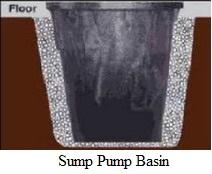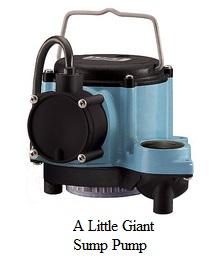
Many homes have some sort of pump system installed to keep water from outside of their homes leaking into their basements. I have had a number of people ask me how this works, so this is the topic for this page.
In the basement of homes, there is a sump basin where water collects. This basin holds anywhere from fifteen to twenty five gallons of water and is a hole that is around two feet in diameter. Once the water has come to a certain level, the sump pump will turn on, take the water up above ground level, and then the water is sent away to be drained into a dry well or storm drain.
There are two different types of sump pumps:
1. Submersible: This type of pump is just like the name says-submersible. They are made to be under water and placed at the bottom of the sump basin. The pump is turned on and off by a ball float that is connected to an internal pressure switch.
2. Upright: This type of pump is also called a pedestal pump (some people use the two names interchangeably, so it is good to know this). This pump has a motor that sits outside of the sump basin, with the pump inside of the basin. It is important not to get the motor wet, as this will ruin the pump. This pump is also turned on and off by a ball float that is inside of the sump basin.
Both pumps require a check valve to prevent the water that has been pumped out from running back into the basin once the pumped has turned itself off. Many pumps come with a battery back-up which is good for individuals who travel and are frequently away from home. It is important to make sure that the batteries in the pump are not dead to avoid coming home to a mess.
If you are wanting to get a sump pump, it is important to find out what the local codes are in your town. Usually the water should be pumped into an area that is twenty feet plus from the home. It shouldn’t drain into the floor of the house or into a person’s septic tank (if they have one). The water needs to be drained in a place to avoid it returning back to the base of the home (as this would be counter-productive).
Now and then, you should make sure that your pump is functioning the way it should. This can be done by first making sure your pump is plugged in. Find the sump basin and make sure that there aren’t any clogs and to see if it is clean inside. Get a bucket full of water (at least five gallons) and pour it slowly into the basin. Make sure the pump turns on after the water has been poured in and that it turns off once the water has been cleared. It may be a good idea to repeat this process to ensure proper function.
I recommend buying a Little Giant sump pump. For tips on which pump you should get visit: https://www.plumbersstock.com/little-giant.html


